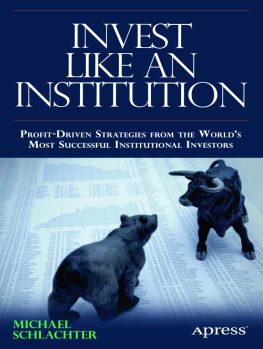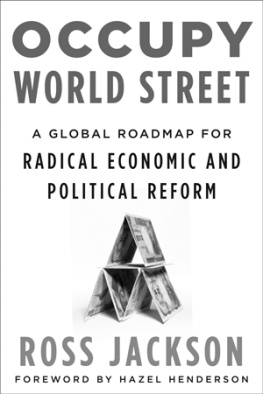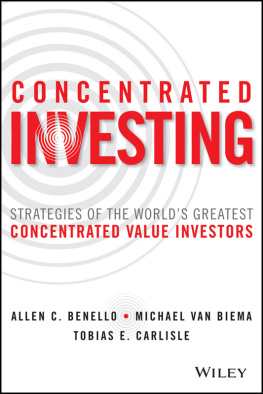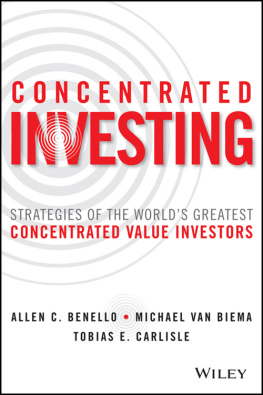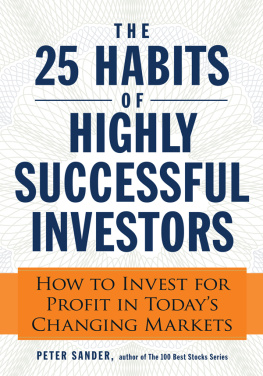Michael C. Schlachter INVEST LIKE AN INSTITUTION PROFESSIONAL STRATEGIES FOR FUNDING A SUCCESSFUL RETIREMENT 10.1007/978-1-4302-5060-9_1 Michael C. Schlachter 2013
Abstract
Large pension plans are the rock stars of the investment world. Everyone in the industry wants to manage a piece of their portfolio, and every industry publication wants to interview their people and discuss their latest move. When the trustees or investment staff at one of these plans makes an asset allocation change or replaces an investment manager, hundreds of millions (or even billions) of dollars can change hands rapidly, potentially making or breaking the careers of individuals working across the financial industry who sell or manage the kinds of portfolios in which large pension plans will invest.
Large pension plans are the rock stars of the investment world. Everyone in the industry wants to manage a piece of their portfolio, and every industry publication wants to interview their people and discuss their latest move. When the trustees or investment staff at one of these plans makes an asset allocation change or replaces an investment manager, hundreds of millions (or even billions) of dollars can change hands rapidly, potentially making or breaking the careers of individuals working across the financial industry who sell or manage the kinds of portfolios in which large pension plans will invest.
Not only are large pension plans revered within the financial industry, but they also have significant advantages over their fellow market competitors, including individuals like you. First, because pension plans generally have huge economies of scale, they are able to negotiate fees that are well below market rates. Because it costs a money manager virtually the same amount in operational expenses to invest $100 million that it does to invest $500 million (just buy five times as many shares, in the latter case), its not uncommon for money managers to be very flexible about the fees they charge pension plans for managing very large portfolios. Second, some money managers will custom-tailor investment portfolios to the needs of the largest plans, and they may even dedicate sales or client service staff to their biggest investors. Some of the very largest pension plans have recently started forming strategic partnerships with investment management firms where they have exclusive access to a firms research and personnel, enabling them to incorporate these unique insights into the pension plans decision-making process.
How can you or I or any individual investor compete against 800-pound gorillas like that in the marketplace? Dont they have all the contacts and information? It sure seems that way when you read the articles in the financial press that glow about the strategies employed by some of the nations largest pension plans that are unavailable to the average individual.
Is there anything the individual can do to level that playing field? At first glance, it may seem like individuals have little chance of competing against these behemoths. However, although it may not be readily apparent at first, there are plenty of opportunities out there for all investors, if they are willing to look for them. In this chapter I address the question of whether there is anything that the major pension plans do that the little investor can replicateeven if he or she must do so on a different scale and with the aid of an off-the-shelf source. In addition, I will identify some possible advantages that individual investors surprisingly have versus these giants.
Although it is important to recognize that the individual investor is very clearly playing the role of David in the battle of David versus Goliath, David can still compete and sometimes can even win, just as he did in the fable. Yes, many advantages flow to the largest players in the investment marketplace, but there are still lots of things you and I can do to level the playing field for ourselves.
Advantages of the Individual Investor
Advantage 1: Freedom from External Pressure Regarding Your Amount of Contributions into Your Retirement Plan
Your largest advantage as an individual investor is that you are free from having to decide in conjunction with external parties how much or how little should be contributed into your retirement savings. If you find that your current savings or your projection of how much you will have saved by a given future date is not sufficient, you can make the decision on your own (or in conjunction with your spouse or heirs) about how to fix that. Do you need to reduce your future expectations of how lavishly you will live in retirement? Maybe downsize the boat or RV you plan to buy someday? Or do you want to double your monthly savings? Any or all of these are reasonable ways to get back on track. Ultimately, the decision over which one to choose is yours, and it can be made relatively quickly and painlessly.
For a pension plan, the decision to modify contributions into the investment portfolio is not nearly that simple. The benefits (the future retirement commitments to employees) are often collectively bargained and contractual, making them extremely hard to changewitness the outrage in 2011 by teachers and others when a newly elected governor reduced pension benefits. Additional funding for a public plan, if needed, comes from the taxpayers, and you are guaranteed that a large fraction of the members of the press, public, and political classes will always object if tax rates or government spending needs to increase, especially in the current economic environment where it seems like every public agency is being asked to do more with less. Although these battles over contributions and benefits can be fought and sometimes won by the powers that rule pension plans, it is far more pleasant to decide with your spouse over dinner one night to find an extra $500 a month to sock away than it is to wage a multiyear war in the courts and press for an additional $5 billion a year of taxpayer money.
Advantage 2: Freedom from Inflated Expectations
Although I dont want to say that pension plans are unrealistic about the future, given that most of their forward-looking return expectations are roughly in line with the 100-year history of market returns, they are uniformly highly optimistic that strong markets and returns will persist in the futurewhich is the second biggest advantage that you have as an individual investor over pension plans. When public pension plans budget over the long term how much the city or state needs to contribute to the plan every year, the calculation is based at least in part on their long-term return expectation, which often ranges between 7% to 9% (one city plan even has a 10% return expectation). The higher the pension plan assumes their future returns will be, after all, the less the taxpayers need to contribute to the plan each year since a higher return assumption means that more of the future benefit payments are expected to come from investment returns, not contributions. A reduction of that discount rate by even as little as 0.25% or 0.50% can mean hundreds of millions of dollars, or even billions of dollars, in required additional annual contributions of taxpayer money to the largest plans to maintain the same level of benefit security. As a result, even though many public pension plan trustees would love to reduce return expectations to better ensure that the fund earns a return at least as good as what is expected of it, the pressure to keep assumptions where they are to minimize increases in required contributions is typically overwhelming from the city or state that sponsors the plan and is facing its own budget squeeze. A rule of thumb that I have observed over the years is that for every 0.25% to 0.50% reduction in the expected future rate of return, a pension plan needs to increase contributions by about 10%. In todays budget environment, that kind of increase in spending by almost any government can be a very difficult proposition, no matter how much it increases the stability and security of the pension plan in the future by decreasing the chance that the long-term returns will underperform that optimistic goal. Instead, cash-strapped plan sponsors often need to maintain aggressive expectations of future returns, resulting in a level of risk required to reach these lofty targets that can lead to significant losses from time to time.

